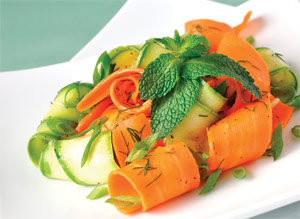- Succession-Planting Interval Chart for Herbs
- Growing Herbs in Containers | Tips for Production of Professional-Quality Container Herbs
- Herb Culture | Comparison Chart (PDF)
- Beyond Cilantro: Top 5 Culinary Herb Trends
- Mouthwatering Combinations: Culinary Herbs + Farm-Fresh Produce
- Destination Herb Farms: Hospitality Farming & Agritourism
- Growing Herb Plants for Direct-Market Sales
- Economic Outlook for Culinary Herbs
- Marketing Herb Plants | Building a Brand for Your Herb Business
- Overwintering Perennial Herbs
- Turning a Profit by Growing Herbs | The Useful Plants
Suggestions for Mouthwatering Combinations
by Lynn Byczynski, Author & Founder of Growing for Market
Culinary herbs are a natural extension of your vegetable production. They are the perfect foil to open discussions with customers and to build relationships with chefs. Whether you enjoy fresh-picked herbs from your own garden or sell your herbs at market, here are some of the many opportunities open to you.
- Grow herbs alongside, and much as you do vegetables: Many can be direct-seeded, including basil, cilantro, chives, parsley, dill, borage. Herb seeds can also be started in the greenhouse and grown into transplants.
- Plant extra herbs to pot up and sell in spring. Individual pots, 2" or 4", are a good choice for most culinary herbs.
- Grow herb micro mix and use baby herbs in salad mix.
- Create patio containers of herbs, lettuces, and edible flowers.
- Many herb flowers are edible; display them as such at your stand.
- Market fresh-cut herbs with vegetables: Fresh dill pairs well with new potatoes, basil with tomatoes, cilantro with peppers, rosemary with winter squash. Provide recipes for less common herbs.
- Sell cut herbs to chefs and, while you're in the restaurant, ask if the bar needs herbs, too. Many trendy cocktails feature leafy herbs such as basil, mint, and lemon balm, and some high-end restaurants make their own herb-infused spirits.
- Grow to serve specific ethnic cuisines: Asian basils, lemon balm, and shiso for Asian cooking; cilantro and tithonia for Mexican.
- Include herbs in cut-flower bouquets as filler, for fragrance, for texture, and for interest. Examples that are good for cutting: cinnamon basil, garlic chives, dill, fennel, mint, oregano, and sage.
- Use culinary herbs as the basis of nonperishable products that you can sell year-round. Meat and fish rubs, herbal vinegars, salad dressings and mixes, and herb-flavored jellies are just a few examples of popular value-added products.
- New to herbs? Read our primer on companion planting. Growing your own herbs is rewarding in and of itself, but growing herb plants offers benefits for vegetable and flower crops grown alongside them that extend to the entire ecosystem.
About the Author
Lynn Byczynski was growing organic vegetables and cut flowers for market when she decided to create a magazine that would help market gardeners nationwide share experiences and information. Her first issue of Growing for Market appeared in January 1992, and GFM has been published continuously ever since, becoming renowned in the market-gardening world for realistic articles that provide practical, how-to information about growing and selling produce and flowers.
Byczynski and her family have been growing vegetables and cut flowers since 1988, selling through CSAs, at farmers' markets, to chefs, grocery stores, and florists. They currently grow cut flowers and hoophouse tomatoes on about 2 acres of their 20-acre farm near Lawrence, Kansas.
She is also the author/editor of two of our favorite books about market farming, The Flower Farmer and The Hoophouse Handbook.
Byczynski and her family have been growing vegetables and cut flowers since 1988, selling through CSAs, at farmers' markets, to chefs, grocery stores, and florists. They currently grow cut flowers and hoophouse tomatoes on about 2 acres of their 20-acre farm near Lawrence, Kansas.
She is also the author/editor of two of our favorite books about market farming, The Flower Farmer and The Hoophouse Handbook.




